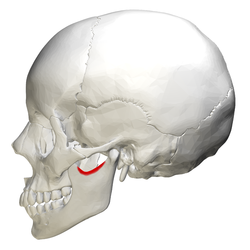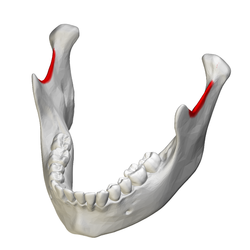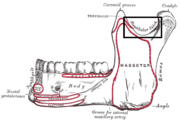| Mandibular notch | |
|---|---|
 Position of mandibular notch in skull, shown in red. | |
 Position of mandibular notch in mandible, shown in red. | |
| Details | |
| Part of | mandible |
| System | skeletal |
| Identifiers | |
| Latin | incisura mandibulae |
| TA98 | A02.1.15.034 A02.1.15.008 |
| TA2 | 871 |
| FMA | 59481 |
| Anatomical terms of bone | |
The mandibular notch, also known as the sigmoid notch, is a groove in the ramus of the mandible. It is the gap between the coronoid process anteriorly and the condyloid process posteriorly.
YouTube Encyclopedic
-
1/3Views:2 445301421
-
Mandible
-
Mandible
-
Anatomy of the Skull (Part 2)
Transcription
Structure
The mandibular notch is a concave groove at the top of the ramus of the mandible. It is the gap between the coronoid process anteriorly and the condyloid process posteriorly.
Function
The mandibular notch allows for the passage of the masseteric nerve (a branch of the mandibular nerve (V3) division of the trigeminal nerve), the masseteric artery, and the masseteric vein.
Clinical significance
The mandibular notch may be palpated to locate the parotid duct,[1] the facial artery,[1] the facial vein,[1] and the medial pterygoid muscle.[2]
Other animals
The mandibular notch can be found in other mammals, such as dogs and cats.[1] There can be significant variation in its shape even within the same species.[3] Archaeological evidence shows that the mandibular notch is different in other hominidae, such as neanderthals, and may be asymmetrical.[4]
Additional images
References
![]() This article incorporates text in the public domain from page 174 of the 20th edition of Gray's Anatomy (1918)
This article incorporates text in the public domain from page 174 of the 20th edition of Gray's Anatomy (1918)
- ^ a b c d Gelatt, Kirk N. (2011). "6 - Surgery of nasolacrimal apparatus and tear systems". Veterinary Ophthalmic Surgery. Saunders. pp. 141–156. doi:10.1016/B978-0-7020-3429-9.00006-7. ISBN 978-0-7020-3429-9.
- ^ Bolton, Kerrie; Selvaratnam, Peter (2009). "23 - Myofascial trigger point treatment for headache and TMD". Headache, Orofacial Pain and Bruxism. Churchill Livingstone. pp. 301–320. doi:10.1016/B978-0-443-10310-0.00023-X. ISBN 978-0-443-10310-0.
- ^ Zelditch, Miriam Leah; Swiderski, Donald L.; Sheets, H. David (2012-01-01). "2 - Landmarks and Semilandmarks". Geometric Morphometrics for Biologists (2nd ed.). Academic Press. pp. 23–50. doi:10.1016/B978-0-12-386903-6.00002-2. ISBN 978-0-12-386903-6.
- ^ Wood, B.; Boyle, E. (2017). "2 - Hominins: Context, Origins, and Taxic Diversity". On Human Nature: Biology, Psychology, Ethics, Politics, and Religion. Academic Press. pp. 17–44. doi:10.1016/B978-0-12-420190-3.00002-8. ISBN 978-0-12-420190-3.
External links
- Anatomy image: skel/mandible2 at Human Anatomy Lecture (Biology 129), Pennsylvania State University
- Diagram at unc.edu



